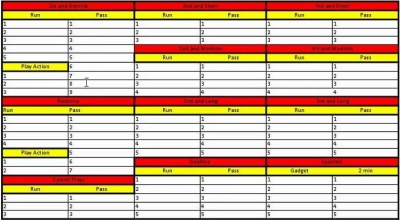By X&O Labs
Twitter: @XandOLabs
Introduction:
 Does this scenario sound familiar? You spend all week studying film, opponent tendencies, drawing plays, teaching your players in the film room and on the field; you have put together what you thought was the perfect game plan only to see your team fall short. The next day you study the film and all you do is ask yourself why did I do that? Why were we trying to be something that we are not? Your film session is filled with players making mental mistakes and not playing like they are capable of playing. This article is designed to highlight some of the mistakes that are common in the game plan process.
Does this scenario sound familiar? You spend all week studying film, opponent tendencies, drawing plays, teaching your players in the film room and on the field; you have put together what you thought was the perfect game plan only to see your team fall short. The next day you study the film and all you do is ask yourself why did I do that? Why were we trying to be something that we are not? Your film session is filled with players making mental mistakes and not playing like they are capable of playing. This article is designed to highlight some of the mistakes that are common in the game plan process.
Mistake #1:
It never fails, you are watching game film on your opponent and the other team is just moving the ball up and down the field at ease, and you think to yourself, “we could do that.” The problem is, their team is making a living throwing the ball 60 times a game and your team is built to run it 60 times. You watch the passing schemes that they are having success with and you immediately run to the dry erase board to draw them up and install them in this week’s game plan. It is okay to borrow one or two plays from someone else but you don’t want to change your offensive identity week to week. You get good at what you do by committing to it and practicing it over and over. As a coach you get a better understanding of what defensive schemes may give you problems and how to make in game adjustments because you know your offense inside and out. A new scheme might look good on film and even in practice against the scouts, but you might know the true ins and outs of it to make it successful on a consistent basis and there is no way your players will not know it well enough to execute it against any defensive package that they might see.
Mistake #2:
The next mistake that you could run into is trying to add too many wrinkles to a play. You are watching film and your offense is moving the ball extremely well and then you get greedy. Instead of just lining up and running a play and trusting that your players will make the right decisions, you try to give them too many checks. It always seems to start off very simple, if they give us a certain coverage, we should throw a quick screen. If they give us a certain front, but the LB is out of place, we should check the run to this gap. So what starts off as one play, now has two or three different components to it. The offense is now at the line of scrimmage thinking about what they might have to do on three separate calls instead of just one. It’s going to slow them down and they will not be as successful as they could be. Remember all eleven players have to be able to execute it, not just the quarterback.









